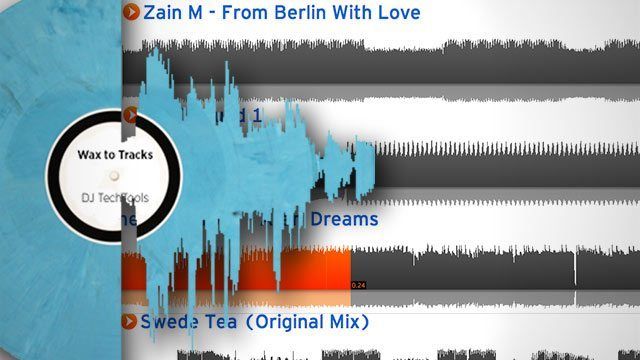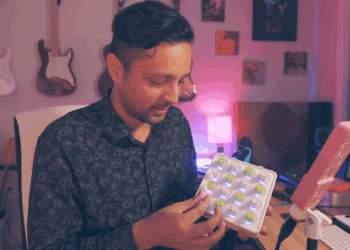Our Wax to Tracks contestants worked hard in Round 1 – not only have they all given their all on their respective projects, but have engaged with Ableton certified trainers and judges to truly flesh out their production abilities. Learn from their experiences inside by hearing how they approached the first challenge, download their Ableton sessions, and read some feedback from major producers.
GETTING UP TO SPEED

It’s been a while since the last Wax to Tracks update, so we here at DJTT figured we’d bring all of those unfamiliar up to speed: we designed this competition to get DJs unfamiliar with producing into the world of creating electronic music by giving them both software and educational resources.
They received a copy of Ableton Live 9, and a pair of AIAIAI TMA-1 Studios to get them started. In addition, they received help from experts Lenny Kiser, Jimmy Allison, Mathieu Valton, and Stefan Knauthe. Their projects can all be heard on our W2T Soundcloud page, and you can download them yourself in the listings below:
RESULTS + JUDGING
In case you forgot (or are just hearing about Wax to Tracks now), each competitor was given a copy of Ableton Live 9 along with a “MIDIpack” created by the DJTT team that featured samples and MIDI data that corresponded to a certain genre that the contestants had mentioned was of interest to them. In turn, each contestant was then in charge of reshaping the elements of the given packs to create something new and original. Each contestant was then judged based on both their original sound design and their incorporation of the sampled elements.

Our judges, Ableton trainer and multi-instrumentalist Alluxe (Laura Escudé) and noted Glitch Mob member Justin Boreta, were kind enough to sit down and listen to each entry carefully and give feedback on each individual element. Below are the results for each contestant – as well as a bit of insight from the competitors themselves:
MESSENGER BOY (DERRICK DOWNEY) – ATARI DREAMS PACK
Download the full Ableton Live project file here.
How’d you approach this track?
To start, I downloaded an assortment of video game samples from NES and Sega Genesis and tried to tell a story using these samples. The first six seconds are supposed to be the title screen of the video game. From :06 to about :30, the player is going through the level— however once the boss battle begins around :30, the tables turn and the player starts getting their ass handed to them by the mega boss! After a dramatic struggle, the player ends up victorious, which is why I changed the key from minor to major at the end.
What did you learn from your Ableton ninja consultation?
This was my first time ever using Ableton, so I got to ask him a lot of questions about the basics. I found it very insightful that he said there’s two different kinds of sidechain functions—sidechaining as a tool used on your tracks to pull out your kick, and sidechaining as an effect used to dramatically add that sucking sound. I think I’ve always approached sidechaining as the effect and never like the tool, so that was very helpful. After quickly discussing these basics, we spent the rest of the time talking about “subtractive mixing” —that is, mix quiet, and if you want to make a part in the song louder, make the other parts quieter.
Justin Boreta: “I love this. Feels like a full on tune you’d hear in a video game; really great chords. I would have loved to hear it be a little longer personally. but that’s not always a bad thing.”
Final Score: 4/5
Laura Escudé Final Score: 3/5
ABADOX (CHRIS RAYMOND) – BROOKLYN BEATS
Download the full Ableton Live project file here.
What was your process like for building this track?
After assembling the Brooklyn Beat layers together, I started to dissect the sounds individually. I liked the layers better in isolation rather than all together and spent time finding what sounds I liked together and the ones I felt were conflicted. Afterwards I began experimenting with the MIDI information, moving around parts and testing out different sounds in places I normally wouldn’t think would fit (eg: switching midi information from harmony to pluck). I used a mix of the pre-generated wav files and created some different sounds with the MIDI information along with simple vocals I recorded in my bedroom thanks to a friend of mine who volunteered to help me.
My process felt a tad unorthodox but I was pleased with its outcome.
What did you learn from your Ableton ninja consultation, and what would you do differently?
Lenny Kiser is an awesome ninja and talented producer. He helped me with some essential Ableton shortcuts and organization methods along with some great tips on Ableton’s built-in and often over-looked audio effects.
If I had the opportunity to start round one over again I would have spent more time on the sound effects that accompanied the track along with differentiating drum patterns to change the pace of the song when necessary.
Justin Boreta: “I love this one. Great emotion, cool arrangement and progression. Good vibes and interesting interpretation.”
Final Score: 4/5
Laura Escudé: 2.5/5
JEREMY SMITH – UNITED STATES OF SYNTH
Download the full Ableton Live project file here.
How did you approach your track?
I was tempted to speed the track up [or slow it] down to my comfort zone but I decided to keep it as is and work outside of my comfort zone. I have a huge appreciation for a diverse range of music and I really like both deep and progressive house. I went through the tutorials and decided the supersaw tutorial was very appropriate to work on a Deadmau5-inspired track.
If you were going to start fresh and do it again, what would you do differently?
I’ve since re-made my own “supersaw” instrument that sounds a lot wider and fatter, so I would probably use that, I would also maybe do a second inversion on the chords instead of just a straight triad chord. I would also fix up the cutoff automation on those chords and maybe take out the lead in the bridge section.
Justin Boreta: “This one has a lot of potential. Sounds great, cool melodies and harmonic ideas. Great sound designs and progression. Feels like half of an idea though.”
Final Score: 3/5
Laura Escudé: Final Score: 2.5/5
RAWS (ROSS LEFKOWITZ) – SWEDE TEA
Download the full Ableton Live project file here.
What was your approach to this track, Ross?
My approach was to try to stay as true to the source material as possible but still try to really make it original. I took the original chords and played with the voice leading and came to a progression I really liked. I kept the song in C major and based it around the piano to make it really happy. My goal was to make a happy summer song. I then gave the track to a friend of mine who sang a few hooks for me so I could put a top end of vocals on it.
What do you think of your track, and what would you do differently?
Overall, I am pretty satisfied with how the song turned out. I feel like some of the levels are off and the low end of the track is too overbearing. This was my first time recording vocals and I enjoyed getting creative with panning different takes and vocals tracks to get some stereo width. I would spend more time on the mixdown and get the levels right. For example and 2:15 there is a little “hiccup” in the music.
Justin Boreta: “Great job, feels like a full song. Keeps the listener’s interest. Great compositlon and fun chords.”
Final Score: 4/5
Laura Escudé: Final Score: 2.5/5
ZAIN MEHDEE – FROM BERLIN WITH LOVE
Download the full Ableton Live project file here.
How did you approach your Round 1 challenge?
I tried to step back from the idea of what it means to ‘work off of pre-existing sounds’. Sometimes it can work really well, and sometimes it can be a train wreck. From the MIDI Pack, I used some parts and didn’t use others. Whether or not I used a certain part was a decision that came from a personal place. I really wanted to spend time with the sounds I received and manipulate them during the sound engineering process. To the point that perhaps if I found a certain aspect of a single midi or audio part which spoke to me, I would use that specific part. However I would mask the sound under many layers of my own design, hence keeping something from what was given but taking it to a place that never existed, all the while keeping myself satisfied that ‘I find it groovy enough’.
What did your consultation session teach you?
I was very happy to have been paired with Stefan (Esky). Besides being a real cool and mellow dude, he was very helpful and really tried to have me start off on the right foot, which I appreciate very much. He helped me get organized and structured for the more things to come, color coding and arranges with cue points, hats off to him!
Justin Boreta: “I like the laid back techno vibe, However it drags on a bit long and lost my attention before the breakdown even hits. Could be cut in half and needs some more movement in the overall progression.”
Final Score: 2/5
Laura Escudé: Final Score: 2/5
FAVORITES FROM THE CROWD
We noted in the last round that we would give out some secret prizes to a few of our audience submissions – you can listen to all of the submissions here, but we’ve made a playlist of our winning favorites – each of which will get a $50 credit in the DJTT store (winners, check your soundcloud inbox!)
ROUND 2: EDITING AND MIXING
In the next round, each contestant will be in charge of doing a “mixdown,” which is really just the process of taking a completed work and mixing the elements (volume, frequencies, etc) to make it sound “finished.” While these are all a bit vague, mixdown is a skill needed by every producer, and we decided to incorporate it to add a more technical element to the competition.
Now: here’s the twist. Each competitor will receive another competitor’s Ableton session! So if one track didn’t shine in the first round, we can’t wait to see what might happen to it given a generous mixing and some basic editing. As always, our contestants will have help from several instructors – and here’s our list of helpful editing and mixing tutorials:
- Tutorial on EQ Sculpting
- Simple but very effective reverb tutorial
- Basics of Compression with Ableton’s Onboard Compressor
- Kill Paris Wants You to Get Mad Famous with Sidechain
- Fundamentals of Bassline Accents and Layering
- Obligatory In-Depth NY/Parallel Compression Tut
You can also participate at home by downloading the packs listed above – just submit your edits and mixdowns to this Soundcloud group. As always, we’ll be keeping an ear to the community in the hopes that we’ve got some great hidden talent on this site!








